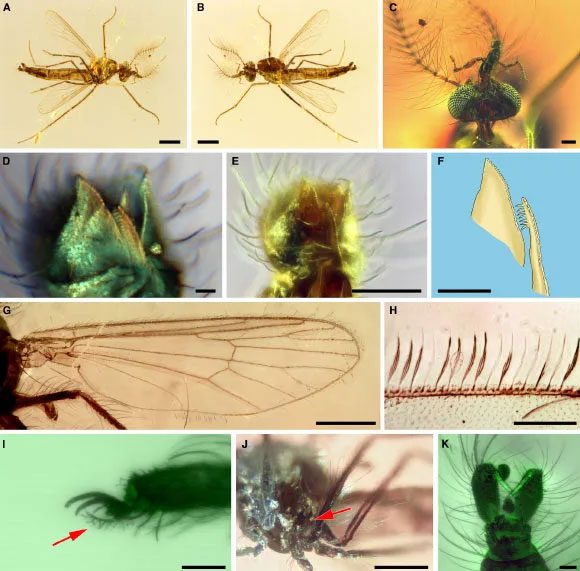Before wreaking havoc on humans today, the ancestors of this creature may have once “brought down” dinosaurs.
A precious amber specimen from Lebanon has preserved the entirely intact body of a small yet fearsome creature that lived during the Jurassic period.
It is a new species of mosquito, with the male “monsters” not only possessing blood-sucking proboscises but also sharp mandibles.

Ancient mosquitoes preserved in Jurassic amber – (Photo: CURRENT BIOLOGY).
This astonishing fossil is a rare piece of evidence of blood-feeding creatures from the Jurassic, which, although small like present-day mosquitoes, might have had enough strength to bring down dinosaurs, just as their descendants cause severe diseases in modern humans.
All living female mosquitoes today are blood and nectar feeders. However, scientists have previously been unsure of when this blood-feeding behavior first developed.
A team of authors from the Lebanese University, the Nanjing Institute of Geology and Palaeontology (part of the Chinese Academy of Sciences), and the National Museum of Natural History in Paris (France) analyzed this specimen.
According to results published in the journal Current Biology, the new fossil not only indicates that the blood-feeding behavior of mosquitoes emerged at least as early as the Jurassic but also suggests that at that time, male mosquitoes were also “vampires.”
The specimens revealed in the fossil exhibit an astonishing level of integrity, from the tiny mandibles and blood-sucking proboscis to the delicate wings. These creatures also represent a newly named species called Libanoculex intermedius.
They belong to a new subfamily of mosquitoes, now extinct, called Libanoculicinae.
This new discovery also pushes back the earliest evidence of mosquitoes from the Cretaceous period to the Jurassic, illustrating that the insect world of this era was remarkably diverse.
It further enhances the value of Lebanese amber, which paleontologists continuously seek after.
“So far, Lebanese amber is the oldest amber containing numerous biological inclusions, making it a very important material because its formation coincided with the emergence and initial spread of flowering plants” – said Dr. Dany Azar from Lebanese University, a co-author, as reported by Sci-News.


















































